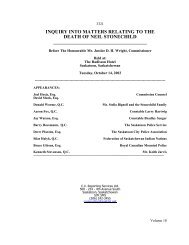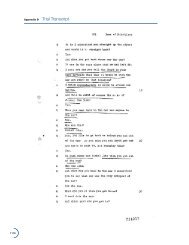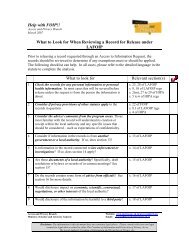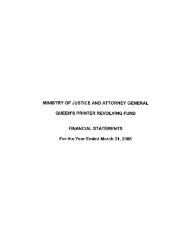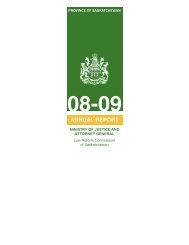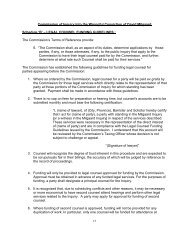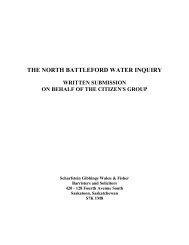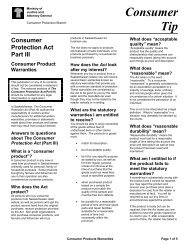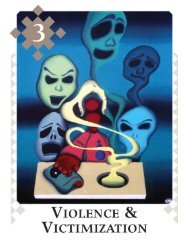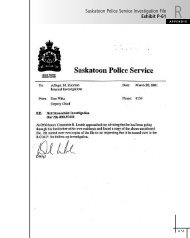Chapter 7 Summary of Findings and Recommendations
Chapter 7 Summary of Findings and Recommendations
Chapter 7 Summary of Findings and Recommendations
You also want an ePaper? Increase the reach of your titles
YUMPU automatically turns print PDFs into web optimized ePapers that Google loves.
<strong>Chapter</strong> 7 <strong>Summary</strong> <strong>of</strong> <strong>Findings</strong> <strong>and</strong> <strong>Recommendations</strong><br />
12. There was a critical failure to record the circumstances <strong>of</strong> Art Roberts’ interview <strong>and</strong> polygraph<br />
<strong>of</strong> Ron Wilson including the questions asked <strong>and</strong> the polygraph results. Roberts did not<br />
provide a report <strong>of</strong> the interview <strong>and</strong> polygraph session.<br />
13. Detective Eddie Karst was a highly experienced, honest <strong>and</strong> skilled investigator. He did not<br />
improperly induce Ron Wilson to make the statements that he gave on May 23 <strong>and</strong> 24, 1969.<br />
14. The Saskatoon Police honestly <strong>and</strong> reasonably believed that Ron Wilson’s inculpatory<br />
evidence provided to Art Roberts had been verified by the polygraph as being truthful, when it<br />
had not. In the circumstances, it was reasonable for the Saskatoon Police to rely on Wilson’s<br />
evidence.<br />
(iv) Nichol John<br />
15. After the polygraph session with Ron Wilson, Art Roberts interviewed Nichol John. She<br />
initially denied that David Milgaard was involved in Gail Miller’s murder, but after continued<br />
questioning by Roberts she told him that she just remembered witnessing Milgaard commit<br />
the murder. John was turned over to the Saskatoon Police <strong>and</strong> the next day gave a written<br />
statement to Raymond Mackie confirming the evidence she reported to Roberts.<br />
16. The Commission lacks evidence to conclude that Art Roberts resorted to outright coercion<br />
during his interview with Nichol John, but whatever he said to her did not produce the truth.<br />
Roberts somehow pressured John into telling him what he thought to be the truth. There<br />
is a clear distinction to be made between coercing evidence from a witness in the sense <strong>of</strong><br />
compelling assent or belief <strong>and</strong> using persuasive techniques such as repetitive questioning<br />
<strong>and</strong> suggestion.<br />
17. There was a critical failure to record the circumstances surrounding Art Roberts’ interview<br />
<strong>of</strong> Nichol John <strong>and</strong> the taking <strong>of</strong> John’s statement by Raymond Mackie on May 24, 1969.<br />
Neither Roberts nor Mackie left a report as to the circumstances surrounding John’s<br />
statement which must now be seen as the result <strong>of</strong> pressure by Roberts.<br />
18. There is no evidence before the Commission to suggest that Nichol John was mistreated by<br />
the Saskatoon Police while staying in the cells on May 23, 1969 or that she was “hysterical”.<br />
The origin <strong>of</strong> this story appears to be the 1981 interview <strong>of</strong> John where Joyce Milgaard told<br />
John her impression <strong>of</strong> what happened.<br />
(v) David Milgaard<br />
19. David Milgaard was cooperative with the police <strong>and</strong> provided blood, hair <strong>and</strong> saliva samples<br />
when requested <strong>of</strong> him.<br />
20. David Milgaard was interviewed <strong>and</strong> questioned by the police in an appropriate manner. While<br />
Milgaard was cooperative, the police found some <strong>of</strong> his answers to be evasive. Milgaard could<br />
not initially give an accurate account <strong>of</strong> his whereabouts or his activities on the morning <strong>of</strong><br />
January 31, 1969.<br />
401



